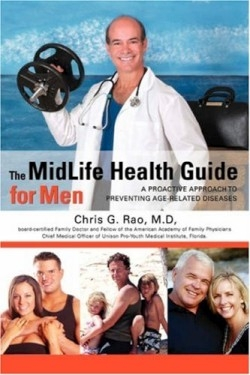The MidLife Health Guide for Men
“Genes will only help you the first half of life…After that it’s the lifestyle you lead from midlife on that determines how well you’ll do” Dr. Chris Rao writes. The author takes a proactive preventive approach to disease and aging in The Midlife Health Guide For Men. Beginning with why we age Rao examines modern developments in understanding nutrition and medicine to help readers maintain good health and vitality into older age than most might think. “Today” he writes a man has “the ability to retain a healthy forty-year-old functioning level well into his eighties.” He covers topics such as diet and nutrition weight loss supplements toxins and hormonal balance. Rao a fellow of the American Association of Family Physicians has also lectured nationally and hosted a radio program.
Rao advocates a healthy diet to prevent conditions of aging. But once these conditions begin to appear he is quite willing to recommend medical treatments or drugs. “We must look at all distinct stages of a disease and then tailor its unique treatments” he writes. “What’s proven to prevent a disease? Then what should we do or don’t do once that disease is present? Lastly what could we do to prevent the return of that particular disease? … it’s not necessarily the same recommendations in all three scenarios.”
The doctor also mentions news reports about the health benefits or dangers of foods supplements or activities and warns readers not to be easily convinced but to examine the facts for themselves. “You should always ask yourself in these instances if the news story actually makes any common sense” he writes. “Does it agree with what’s been proven for decades? Does it disagree with common practices or health beliefs that have been passed down for generations?” At one point he tells readers that Momma was right: Cod liver oil is good for you.
Beyond common sense Rao provides plenty of technical health information—perhaps too much at times. Nearly half of the book deals with hormones and goes into detail about deficiency symptoms studies and replacement therapy. He spends forty-nine pages on testosterone alone. He has written most of the book in plain English that all can understand even spicing it occasionally with colloquialisms or slang. But once in a while he slips into medical jargon that will have readers running for the dictionary.
The book is readable but redundant at times and could do with further editing. A referenced questionnaire on detoxification is missing from the appendix. The author has not discovered glyconutrition and some of the tables and charts reproduced by a photo process are practically indecipherable. Nutrition buffs will be put off by drug recommendations but the target audience of the average man approaching or into middle age would benefit from Rao’s balanced advice.
Disclosure: This article is not an endorsement, but a review. The publisher of this book provided free copies of the book and paid a small fee to have their book reviewed by a professional reviewer. Foreword Reviews and Clarion Reviews make no guarantee that the publisher will receive a positive review. Foreword Magazine, Inc. is disclosing this in accordance with the Federal Trade Commission’s 16 CFR, Part 255.

